What makes a barren a barren? This half acre in Plattsburgh New York is really cool stuff. First; summer here was hot and
dry. A good chunk of my beloved Hudsonia heath on this tiny chunk of earth appears to be quite dead as a result.
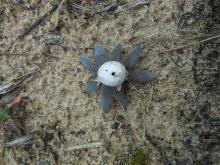
Here's a survivor patch of Hudsonia tomentosa, a very special little plant and pretty much the reason I return here again
and again. I associate moss of the type seen in these two photos with clay soils. This habitat exists on back dunes at the
city beach; pure sand; whats going on?

A sedge is at work stabilizing the area. It grows almost as a mono-culture here. The Hudsonia grows on the dunes that,
apparently, aren't tacked down yet. The second photo depicts a peat wrack; I was surprised at the effect of a recent heavy
rain, not only was there this effect but quite a bit of sand had been moved off of the less stable dunes; and washed into
the Hudsonia plants on the slopes. I would have thought the rain to soak in more; it is, after all, sand; and cause less
erosion.

This little plant is another begging the question. I think it is a Lechea sp. The rather concise growth of the basal
rosette is quite catchy but there is no stunning floral display. I've seen this genus on a baked southern exposure in thin
rock ledge soil also: SO 'NOT' HERE! But.... The second photo is a pretty little oak. In fact, not 50 yards to the west is
a tall forest of poplar, willow, et. al. so why is this just a pretty little oak? The entire affair sits pretty much on
the water table of Lake Champlain so a degree of anoxyia at the roots may be involved but the larger trees to the west
don't seem bothered by this handicap. What's up?

This little everlasting looks to be extremely rare on this site. It seems biennial -a strategy of nature that probably
works when it does and is otherwise pretty risky. Photos are of rosette and flower scape.
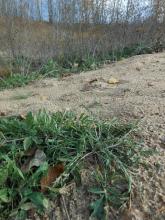

Comments
Michael Peden
Re: An Acre Sacred
Sat, 10/27/2012 - 7:57amThis shares the same issue with other nice beaches on Lake Champlain; the slope is quite shallow. This exposes a lot of sand to
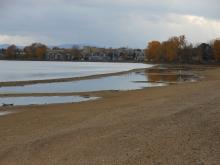
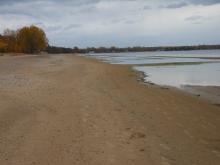
wind.
Fungi are proof of some good biological activity going on here.

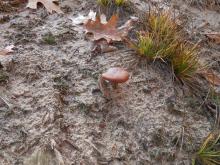
This could be trouble: Centaurea (maculata) an exotic I'm used to seeing on shale barrens and clay is moving in; so again;

why does it seem to care so much for this sand?
A nice young Hudsonia and another overview of this tiny dune habitat. I note that a much larger area just north of this
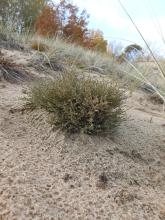
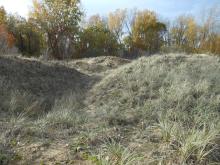
has been developed. The Crete Memorial Civic Center sits there on its expansive lawn and asphalt parking lots. Trees have
been removed etc. Perhaps given back to nature another dune habitat would develop in time on this site.
Michael Peden
Re: An Acre Sacred
Sat, 10/27/2012 - 8:22amAnd just for fun and for what it's worth: The whole area might be underlain by limestone. But I have no drill core data
handy to substantiate this speculation which I base on the surrounding area; one of marsh and low limestone outcroppings.
The thought arises: Is there something electrical going on here with a relatively thin layer of silica -being permeated
with organic acids- on top of basic rock. I also consider the possibility of a relationship, as concerns plant roots
anyway, between this very fine moist sand and clay. Both are silicates. This considered, the place can not be completely
devoid of calcium, a basic metal, as bits of shell become part of the sand that's constantly blowing around. So there's that too! Good
puzzle! The photo is of Zebra Mussel wrack at Plattsburgh City Beach. The Zebra Mussel is exotic to Lake Champlain. When I was growing up in Essex, NY we did not have these.
Richard T. Rodich
Re: An Acre Sacred
Sat, 10/27/2012 - 8:40pmI don't know about something electrical, but an acidic medium atop a limestone bedrock isn't that unusual here in Minnesota. I would think that where you have limestone in the northeast US, it would be the norm.
Lori S. (not verified)
Re: An Acre Sacred
Sun, 10/28/2012 - 8:48amI don't think I'd bother taking the precaution of wearing rubber-soled shoes there, Michael! ;D
Interesting plant life... Hudsonia tomentosa looks like it can be quite spectacular in bloom:
http://www.minnesotawildflowers.info/flower/beach-heather
What is the plant in your 4th photo?
Trond Hoy
Re: An Acre Sacred
Sun, 10/28/2012 - 2:06pmAn interesting spot, Michael Now I am looking forward to the winter, spring and summer reports!
I am familiar with silicate sand on clay as one of my favorite islands consists of that! The flora is quite different however ;) Hudsonia seems to be a showy plant. Is it possible to grow in a garden?
I have never seen the Zebra mussel but know it is native in southern Russian rivers like Volga and Dnjepr. It is introduced to almost all Europe except Norway so far.
Richard T. Rodich
Re: An Acre Sacred
Sun, 10/28/2012 - 7:02pmHudsonia tomentosa grows in our "dunes" in Minnesota, too. Here it is at Weaver Dunes Scientific and Natural Area, one of the rare places that still has active blow outs. Keep in mind that these pics were taken in late March, well before new growth begins, and after a much harsher winter for anything evergreen than those experienced in the eastern USA. I had thought they were interesting, so I took photos for myself; I had never dreamed they would find themselves here on the forum. ;D
The Hudsonia is the dark spots in the middle and to the right.
Richard T. Rodich
Re: An Acre Sacred
Sun, 10/28/2012 - 7:20pmFor those interested, the minnesotawildflowers.info site is a very accurate source, although very limited in scope. And it is one of the few places that consistently posts more photos than just the flowers. Katy Chayka (site author) has an active Facebook page where she posts many more species, according to my friend. I have yet to be on Facebook, as I still clunk along with a W2K operating system. That's soon to change, I hope.
Trond Hoy
Re: An Acre Sacred
Mon, 10/29/2012 - 1:04pmRick, the minnesotawildflowers.info site is interesting! And so is the Hudsonia "heath" Have anybody tried it from seed?
I am no Facebook'er either although quite a few have asked me. Don't think I'll be a follower either :-\
Mark McDonough
Re: An Acre Sacred
Mon, 10/29/2012 - 2:57pmSeeing this note about FaceBook, I just signed up for minnesotawildflowers FB page, it's very good.
cohan (not verified)
Re: An Acre Sacred
Sun, 11/04/2012 - 3:50pmInteresting site, Michael, and all quite alien to me- neither sand nor limestone in my immediate environs (though of course I might see one or the other -not together on any location that comes to mind- if I travel a bit farther); the fact that it's a small patch of this biotype would make it all the more precious..
I think I had Hudsonia seed from Kristl, though I can't remember for sure.. if so I think I may have had seedlings but not long term survivors (more likely an issue with my soil mix or siting of pots than anything else), something I'd try again..
As to Facebook, I didn't get into it for some time, but in fact there is an amazing and vast world of plant stuff on there too-- we plantophiles will rapidly colonise any available venue!